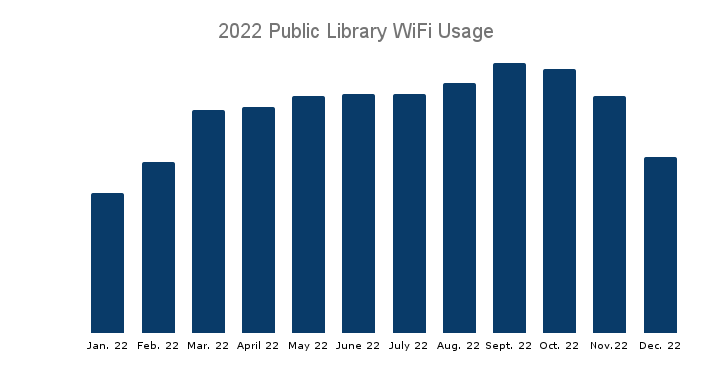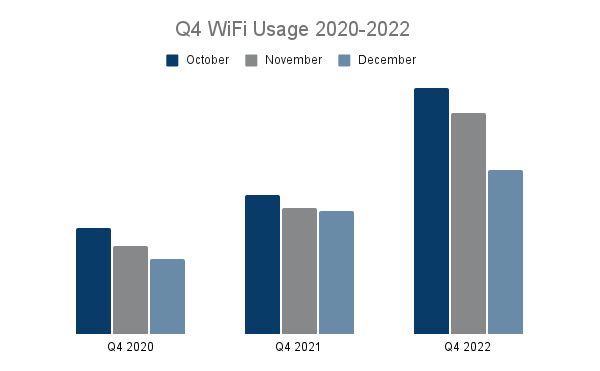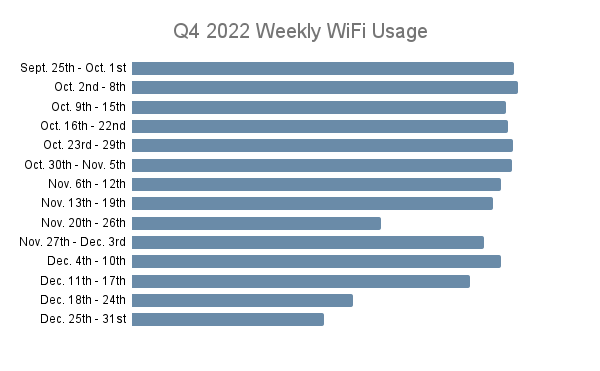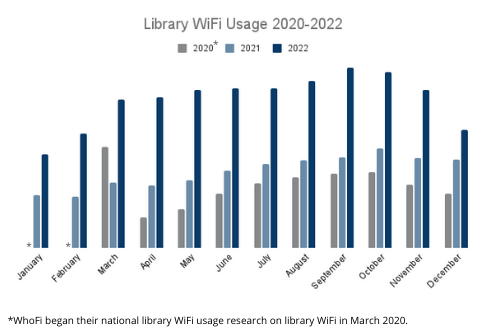Annual Analysis of Public Library WiFi Usage in 2022
WhoFi analyzed data from our library partners to identify library WiFi usage trends. This report includes our findings for 2022.
Public Library Insights for 2022
Looking over the WiFi insights from 2022 there were encouraging trends indicating that library service usage is growing and seasonality may be more predictable in the coming years. When we conducted our research using data from libraries throughout the United States there were positive signs of continued growth in usage for services like WiFi. These services offered in communities by libraries are vital for many who would otherwise lack connection, and in 2022 libraries were as close as they have been to pre-pandemic usage.
As the world continues to seek a “new normal” post-pandemic we may be closer to finding just that. This year many systems and larger library groups saw usage numbers within 90% of usage prior to the beginning of the COVID-19 pandemic. As more and more of the community came out to engage with the library for education, research, and internet access we also began to see more predictability surrounding changes in seasonality and major holidays. This return to standard usage patterns could be a further indication that libraries are one step closer to the “new normal” following the pandemic.
In 2022 libraries seem to be adjusted to having both in-person and virtual programs. Most have now returned to full in-person service. During the pandemic many libraries adjusted their program and service offerings to include upgrades like faster WiFi, virtual programs, and even expanded WiFi coverage outside of the building. This year we saw sustained growth among casual and frequent users as well as greater similarities between population groups.
Why more patrons visited libraries in 2022
We continued to see numbers closer to those before the COVID-19 pandemic began in 2020. Increase in usage could be attributed to a number of factors including decreased infection numbers, better treatment, vaccines available to all ages, as well as a growing remote workforce. The remote workforce in particular could be drawn to the library for their WiFi in order to conduct important Zoom meetings, document uploads, and other important tasks that require faster internet speeds. The data shows that the number of patrons taking advantage of the many resources libraries offer has increased to levels not seen in the past couple years, as we can see in this year-over-year comparison of Q4 usage.
How seasonal decreases in Q4 may be a positive sign
As in previous years, there was a decrease in usage during the fourth quarter of 2022 likely attributable to seasonality decreases around Thanksgiving and Christmas. Looking at the data we can see that the week of Thanksgiving had a noticeable decrease in usage and the week leading up to and following Christmas were even lower. This drop in usage during the holidays is fairly ubiquitous over the years. The fact that seasonality was the major driver of changes in 2022 as opposed to pandemic years is a positive sign that we are approaching a “new normal” for library usage.
Return of the casual library user
Libraries over the past two years have slowly opened their doors to the public and the first high usage patrons to return were of course those who relied on the library most consistently. High use patrons were also those that returned on a regular basis to utilize library information, internet, and in-person programs first. Casual users are those who visit the library on occasion to check out books, attend programs, or utilize public computers and the internet. In 2022 we saw those patrons who are returning to public spaces and gatherings for the first time since the pandemic shutdowns began in addition to high use patrons. This return of the casual user could indicate nearing a return to normal in 2022.
Interpreting insights for 2023
The data from 2022 reveals that communities continue to rely on libraries for consistent internet connection and services at an increasing rate. We can see that libraries have an important role in bridging the digital divide in communities. Providing a safe space for patrons to conduct research, study for school, work remotely, and gather for events are just a few of the areas where libraries are contributing to their communities. As more casual users return to libraries we have further indications that libraries continue to be an essential service for communities. WhoFi will continue to monitor these and any new trends that arise in 2023.
Understanding how patrons utilize library services allows library staff to make data-influenced decisions on how best to engage with their community. Insights from WiFi analytics will continue to be beneficial to libraries in planning and advocating for the future of their institutions.
Libraries that partner with WhoFi have helped simplify the reporting processes while ensuring the information collected is standardized for the library board, state and IMLS reporting. If you would like to learn more about how we help libraries reduce reporting burdens, we would like to hear from you. Please visit WhoFi.com/Demo to schedule a meeting!




